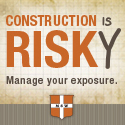
| www.agc.org • May 2017 |
Contact Us Archives
Subscribe Printer-Friendly AdvertiseSafety and HealthFacebook |
Creating a Safety-First Culture
BY JERRY FLEMMING
VICE PRESIDENT OF RISK MANAGEMENT,
JAMES MCHUGH CONSTRUCTION CO.
Organizational culture, while notoriously difficult to define, is a driving force in organizations. It is responsible for shaping employees’ attitudes, guiding behavior, creating a sense of identity and establishing consistency. Often, corporate culture can be more influential than a company’s written rules or regulations, so establishing one that prioritizes safety is critical to companies operating with the general contracting industry.
Contrary to popular belief, a safety-first culture is not achieved through EMR scores, OSHA numbers or financial statements. It is not built on insurance rates or successful bids; it’s built on (and built by) people. A safety-first culture helps construction field teams – those removed from the financial side of risk management – answer the question: why does safety matter to me?
While creating and maintaining a safety-first culture is the objective, it is not without its challenges; project demands may require faster-than-average onboarding, subcontractors may not place a similar value on safety and specific job challenges may force companies into reactive positions.
But despite the job-specific challenges that might arise, it is possible to create—and sustain—a safety-first culture. Here’s how.
BUILD A TEAM OF SAFETY CHAMPIONS
The nature of culture is such that it cannot be defined or directed from the top; instead, culture emerges naturally from a set of norms, values and beliefs shared by individuals throughout the company.
It is impossible to separate a safety-first culture from those who live and breathe it every day. In this vein, it benefits risk management leadership to build a team comprised of individuals whose core values align with the company’s long-term safety objectives—safety champions.
First, start at the top by securing buy-in at the highest levels of the organization. If executives aren’t visibly championing risk management, not only will middle management place a low priority on safety, but field teams could end up paying lip service to safety policies and procedures on the work site.
Next, reinforce the executives’ commitment through a robust recruitment effort. Challenge hiring managers to never stop scouting the company’s next safety advocates and design recruitment tools in a way that requires interviewees to demonstrate their commitment rather than just talking about it.
Finally, once a committed team has been assembled, make every effort to engage and retain employees who embody the safety-first mindset. Offering public praise and building in time for employees to share their feedback will help your organization retain its most valuable assets: its safety champions.
ELEVATE (AND REINFORCE) EXPECTATIONS
In a safety-first culture, a company’s commitment to risk management cannot be overstated or overemphasized. Set the expectation early and reinforce the message often: there is no greater priority than safety.
To achieve this company-wide safety mindset, challenge leadership in your organization to go beyond what is required by legal and regulatory entities when it comes to safety. After all, meeting minimum requirements demonstrates a minimum commitment.
In practice, this might manifest in extended onboarding for employees, the requirement of supplemental industry—or role-specific—certifications, or ongoing professional development programs for employees throughout the organization.
Day-to-day reinforcement of the expectation is also needed to drive the safety-first mindset. For example, holding ‘stretch and flex’ sessions at the start of the workday emphasizes the importance of physical wellbeing, and making safety a central topic at pre-task meetings and town halls reminds teams that risk management is always top of mind.
In short, there can never be too many touch points when it comes to promoting the safety-first culture.
HUMANIZE RISK MANAGEMENT
It’s the job of every risk manager to recognize that the safety topics that dominate the board room don’t always translate to the work site. Field team members often are less compelled by the financial implications of risk management and more moved by its day-to-day consequences.
Risk managers should look for ways to humanize safety, to bring the broader risk management concept to life on the construction site. This can be achieved by discussing the consequences of individual risky behavior for the people working alongside field team members every day.
Make safety personal by encouraging your team members to get to know one another, by sharing stories of ‘close calls’ within the industry, and by discussing errors—even those made at the leadership level, which can be a great source of learning and development (and may help build loyalty and gain buy-in).
A candid dialogue that humanizes the topic of safety will inspire a safety-first culture more than a discussion of insurance rates ever could.
EXPAND THE SCOPE OF SAFETY
Risk management should extend to all four corners of a general contractor’s operations, but that alone will not set the stage for a safety-first culture.
Most employees who embody the safety mindset have an innate, personal commitment to managing and reducing the potential for risk both on and off the jobsite. The value they place on safety does not evaporate when they leave work; rather, it permeates all facets of their lives. Only when you have enough people with this same conviction can a safety-first culture thrive.
Risk managers can promote the safety-first mindset on the clock by discussing safety off the clock. Build time to review everyday safety practices that team members might not expect to hear at work: safe driving behaviors, proper workout techniques, in-home fire alarm checks, even safe cooking techniques around the holidays.
Leadership can go a step further by formalizing programs that underscore its commitment to employee wellbeing beyond the jobsite. For example, consider sharing a "safety tip of the month," which may be unrelated to construction; instituting a company-wide health and wellness initiative; or encouraging employees to earn CPR certification. These programs not only provide direct benefit for employees, but they make your company values tangible and actionable.
MAKE SAFETY FUN
There will always be a place for serious conversations on the impact of risk management on business outcomes. It’s Business 101 – there is no risk management function without a profitable business, and there is no profitable business without a high-quality risk management function.
That said, there is measurable value to employing programs and tactics that make safety fun, programs that bring the concept of safety out of the often-tense space it occupies. In fact, research suggests that inserting humor into training may improve learning outcomes.
Enlist the help of your team to make safety fun – there is no shortage of ways to do so: safety role playing at all team meetings; short, educational videos designed to jumpstart important safety conversations; creative incentive programs for employees who go out of their way to make the company a safer one.
At the end of the day, the best thing risk management leaders can do to make safety fun is to recognize and show appreciation for the efforts of their teams. A ‘thank you’ or ‘great job’ can go a long way toward making safety fun.
Culture is a powerful driving force within organizations, and it is up to risk managers to nurture an environment where a positive culture—one that prioritizes safety—can thrive.
This environment is not cultivated by excessive auditing or constant review of financial implications of safety. Rather, it’s built by committed individuals who demonstrate an unwavering commitment to safety and are willing to make sacrifices. After all, prioritizing safety above all else means days may run long and construction may stall. But the alternative is not an option.
By building a team of safety champions, elevating company expectations, humanizing risk management, expanding the scope of safety and inserting some fun along the way, a safety-first culture—and a better company—can be achieved.
Jerry Flemming is the vice president of risk management for James McHugh Construction Co., a Builders Association member, in Chicago. Flemming has more than 25 years’ experience in safety and risk management. Since joining McHugh in 2011, Flemming has guided the company to achieve its lowest Experience Modification Rate—0.46—while overseeing some of McHugh’s most complex and expansive projects to date. He continually challenges safety assumptions and is always looking for ways to improve and advance the risk management function. |
|||
 2300 Wilson Boulevard, Suite 300 · Arlington, VA 22201 · 703-548-3118 (phone) · 703-548-3119 (fax) · www.agc.org
2300 Wilson Boulevard, Suite 300 · Arlington, VA 22201 · 703-548-3118 (phone) · 703-548-3119 (fax) · www.agc.org
About AGC | Advocacy | Industry Topics | Programs and Events | Career Development | News & Media
© Copyright 2025 The Associated General Contractors of America. All rights reserved.

